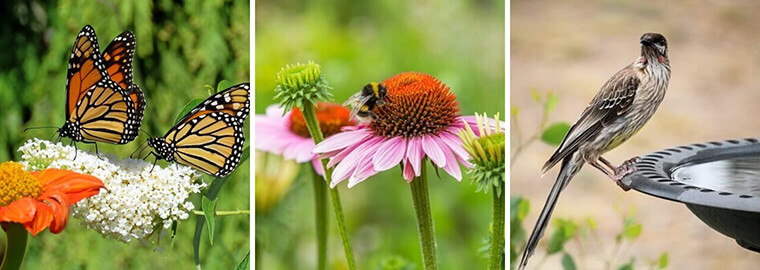 Back to the Be Inspired Blog
Back to the Be Inspired Blog

How To Certify Your Green Space As A Wildlife Habitat
Have you ever fantasized about transforming your backyard into something new? There’s a fast-growing trend across the United States encouraging anyone with access to a green space to certify it as an official wildlife habitat.
According to the National Wildlife Foundation (NWF) there are more than 150,000 certified wildlife habitats across the country. They’re outside schools, businesses, places of worship, community gardens, nature centers, apartments and homes just like yours.
What qualifies a backyard as a wildlife habitat or sanctuary?
Whether you have only a small space to spare, or acres of land, anyone can participate in the NWF’s program. Chances are, you’ve already taken some of the necessary steps.
- Provide a minimum of three food sources.
This can come from food provided naturally by plants (like seeds, nuts, berries, fruits, etc.) or from supplemental feeding through feeders. Especially during the cold months, feeders provide much-needed support to birds, butterflies and squirrels.
- Provide at least one water source.
If you live on a lake or have a pond on your property, you can cross this one off easily. For most, however, a small dish filled with pebbles and water for birds and bees and be plenty. If you buy a bird bath, make sure that it’s something wildlife can actually use – many of the ornamental styles have edges that are too steep and slick, which prevents birds from feeling safe while drinking or bathing.
- Provide at least two sources of cover.
For individuals who prefer a neatly trimmed and kept yard, providing cover may take a little extra work. Birds prefer dense wooded areas, shrubs or thicket, and even rock piles. These “messy” features provide the perfect cover for birds to safely scope out their surroundings before heading into the open for food or water.
- Provide two places where wildlife can raise their young.
In an urban setting you can use a birdhouse, a small tree in a patio container, or even a host plant for your local butterflies.
- Commit to sustainable gardening practices.
From the NWF’s website, you need to use at least two of the following three categories to help manage your habitat in a sustainable way.
- Soil and Water Conservation: Capture rain water from roof, drip or soaker hose for irrigation, limit water use, reduce erosion (i.e. ground cover, terraces), use mulch or create a rain garden.
- Controlling Exotic Species: Practice integrated pest management, remove non-native plants and animals, use native plants and reduce lawn areas.
- Organic Practices: Eliminate chemical pesticides, eliminate chemical fertilizers and compost.
- The Final Step: Get Your Backyard Wildlife Habitat Certified!
Go to the National Wildlife Foundation’s website, check the boxes that apply to your space, elaborate a little bit on your habitat and pay the $20 fee, which gets you a subscription to the NWF’s magazine, a certificate and also goes towards NWF outreach. You can also spring for the $30 sign. It won’t help attract more wildlife, but it might inspire neighbors to create their own wildlife habit.
Let The Experts At SummerWinds Help You Design Your Wildlife Habitat.
If you need any suggestions on picking out native plants, organic pest control, irrigation, accessories or more, please stop in to any one of our Bay Area locations. Our garden experts will be more than happy to help with your project.





